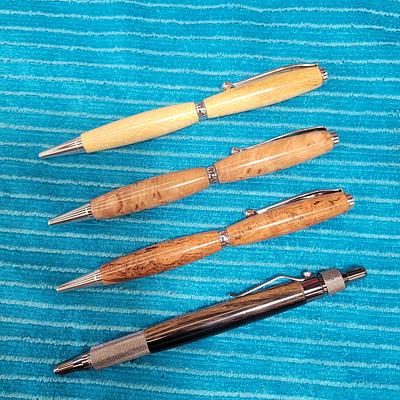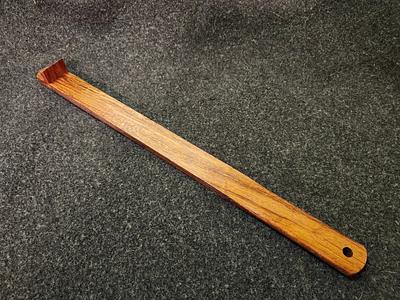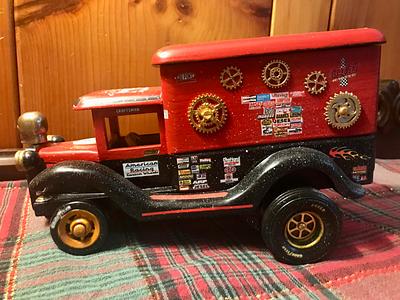Share your craft projects
Make new craft buddies
Ask craft questions
Blog your craft journey
Mastering Woodworking with Power Tools: A Comprehensive Guide
If you are seeking to advance your woodworking skills to a higher level, the utilization of power tools offers a means to achieve precise cuts, smooth finishes, and increased efficiency in work processes.
This article delves into the advantages of incorporating power tools into woodworking practices, examines the various types of tools accessible, provides guidance on selecting the appropriate tools for specific projects, outlines essential safety measures to be mindful of, discusses fundamental and sophisticated techniques for utilizing power tools, and offers maintenance recommendations for the preservation of tool longevity.
Irrespective of whether you are a novice or a seasoned woodworker, this article caters to individuals at all skill levels.
.jpg_11.jpeg)
Benefits of Using Power Tools
The advantages of utilizing power tools in woodworking are manifold and substantial. Power tools contribute to efficiency, accuracy, and speed when engaging in woodworking endeavors.
By integrating power tools into one's woodworking methodology, there is a significant boost in productivity, allowing projects to be completed in a fraction of the time required by traditional hand tools. The precision offered by power tools ensures that cuts and joints are executed with exactitude, resulting in a superior final product. The utilization of power tools, such as electric saws and drills, not only enhances workflow efficiency but also minimizes physical strain on the user.
The incorporation of power tools into one's array of woodworking equipment has the potential to transform craftsmanship and enhance the quality of projects.
Types of Power Tools for Woodworking
Having a comprehensive understanding of the different types of power tools used in woodworking is crucial for individuals at all levels of expertise, whether they are beginners or seasoned professionals. The array of power tools available for woodworking includes saws, drills, sanders, and routers, with each tool serving a specific purpose in various woodworking projects.
Overview of Different Tools and Their Functions
A comprehensive examination of various power tools and their functions in woodworking offers valuable insights into the range of equipment available for diverse tasks. It is essential to comprehend the purposes and capabilities of tools such as saws, drills, sanders, and routers to facilitate effective project completion.
Saws play a foundational role in woodworking, encompassing a variety of options like circular saws for precise straight cuts and jigsaws for intricate curves. Drills are critical for boring holes, with cordless models providing enhanced mobility and adaptability. Sanders, including belt sanders and palm sanders, prove instrumental in achieving refined finishes on wooden surfaces. Routers, recognized for their accuracy in shaping edges and crafting intricate designs, hold critical significance in cabinetry and furniture production.
Each of these power tools fulfills unique functions and addresses specific woodworking requirements, ensuring the attainment of precision and efficiency in the outcomes of woodworking projects.
Choosing the Right Power Tools for Your Project
Choosing the suitable power tools for a woodworking project is a critical decision that significantly influences the project's final result. It is imperative to have a thorough understanding of how to select the correct tools based on the project's specifications, scale, and materials to ensure a successful completion.
Considerations for Tool Selection
In the realm of woodworking, the selection of power tools demands careful consideration of various factors to inform the decision-making process. Critical elements such as project intricacy, financial limitations, tool adaptability, and safety provisions significantly influence the identification of the most appropriate tools for the task at hand.
A comprehensive comprehension of the unique prerequisites associated with each woodworking endeavor proves essential in ascertaining the power tools that align most effectively with individual requirements. For instance, engagements involving detailed designs or fragile wood components may necessitate the acquisition of precision tools like jigsaws or scroll saws. Conversely, undertakings characterized by robust cutting or shaping requirements mandate the inclusion of tools such as table saws or routers to facilitate the desired outcomes.
Ensuring a harmonious alignment between the functionalities of the tools and the exigencies of the project is paramount in attaining optimal results and efficiency within the realm of woodworking pursuits.
Safety Tips for Working with Power Tools
Emphasizing safety in the operation of power tools within woodworking is of utmost importance to prevent accidents and maintain a secure working environment. The implementation of rigorous safety protocols and adherence to established best practices can notably diminish the likelihood of injuries and incidents.
Important Safety Precautions
Woodworkers are required to follow important safety precautions while using power tools to minimize the likelihood of accidents and injuries. Creating a safe working environment, wearing suitable protective equipment, and adhering to safety guidelines specific to each tool are crucial practices to guarantee personal safety.
Regular inspection of power tools for any damage or defects before each use is essential. Woodworkers must also ensure that electrical tools are properly grounded to prevent electric shocks. When working with sharp cutting tools like saws and routers, maintaining focus and avoiding distractions are key in accident prevention.
In case of emergencies, woodworkers should have quick access to a first-aid kit and a clearly outlined evacuation plan. Emphasizing safety at all times is of utmost importance in woodworking projects.
Basic Techniques for Using Power Tools
Developing expertise in fundamental techniques for utilizing power tools is essential for the advancement of woodworking skills. Proficiency in basic tasks such as cutting, drilling, sanding, and routing enables woodworkers to carry out projects with accuracy and effectiveness.
Step-by-Step Instructions for Common Tasks
Adhering to a systematic approach for fundamental woodworking activities involving power tools can optimize efficiency and precision in project implementation. Proficiency in the sequential steps for tasks such as cutting, drilling, sanding, and finishing is paramount for achieving the desired results.
When engaging in cutting tasks, it is imperative to ensure that the saw blade is sharp and correctly aligned before initiating any cuts. During drilling operations, the selection of an appropriate drill bit size tailored to the specific job requirements is critical, alongside securely fastening the workpiece in place. Sanding plays a crucial role in refining rough edges; hence, a progression from coarse to fine grits should be employed.
In the completion stages of a project, the application of even coats of the preferred finish using elongated, smooth strokes is recommended. Emphasizing safety measures by donning protective equipment and adhering to the manufacturer's guidelines for each power tool employed is essential throughout the woodworking process.
Advanced Techniques for Power Tool Woodworking
Examining sophisticated methods in power tool woodworking provides seasoned woodworkers with fresh opportunities for creativity and precision in the execution of projects.
Immersing oneself in intricate designs, complex techniques, and innovative approaches can enhance woodworking projects to superior levels of craftsmanship.
Tips and Tricks for Experienced Woodworkers
Experienced woodworkers can derive advantages from valuable tips and tricks that enhance their efficiency, creativity, and project outcomes when utilizing power tools. The utilization of expert insights, innovative strategies, and time-saving techniques has the potential to streamline workflow and elevate woodworking craftsmanship.
Incorporating intelligent work habits, such as proper tool maintenance and blade sharpening, enables woodworkers to ensure that their equipment functions optimally, resulting in precise cuts and smoother finishes. Effective organization of the workspace to facilitate easy access to tools and materials helps minimize time spent searching for items.
The implementation of advanced techniques like jigs and templates can assist in achieving consistent results. Additionally, keeping abreast of the latest woodworking trends and equipment innovations fosters ongoing skill enhancement and product diversification.
Maintenance and Care of Power Tools
It is imperative to adhere to proper maintenance and care protocols for power tools to guarantee their durability, functionality, and safety throughout woodworking tasks. Consistent cleaning, inspection, and maintenance routines play a vital role in prolonging the longevity of tools and optimizing their operational effectiveness.
Proper Cleaning and Maintenance to Extend Tool Lifespan
The implementation of proper cleaning and maintenance routines is essential for prolonging the lifespan and maintaining the functionality of power tools used in woodworking. Engaging in regular cleaning, lubrication, and inspection procedures can effectively prevent wear and tear, thereby ensuring optimal performance and longevity of the tools.
It is imperative to diligently remove any debris or sawdust from the tools following each use, as the accumulation of such particles can significantly impact the tools' performance over time. Conducting routine inspections to identify loose parts, damaged cords, or worn-out components is crucial to addressing potential issues at their onset.
When storing power tools, it is important to place them in a dry and well-ventilated environment to prevent rust and corrosion. Furthermore, regular checks of power cords for any signs of fraying or damage are necessary, and immediate replacement should be carried out to mitigate the risk of electrical hazards.
Frequently Asked Questions
What are power tools used for in woodworking?
Power tools are used to make woodworking projects easier and more efficient. They can be used for cutting, shaping, sanding, and drilling wood.
What are the different types of power tools used in woodworking?
There are various types of power tools used in woodworking, such as circular saws, jigsaws, routers, sanders, and drills. Each tool has a specific purpose and can help achieve different woodworking techniques.
Are power tools safe to use for woodworking?
When used properly, power tools are safe to use for woodworking. However, it is important to follow safety precautions, wear protective gear, and read the instructions before using any power tool.
How do I choose the right power tool for my woodworking project?
The right power tool for your project will depend on the type of woodworking technique you are using and the type of wood you are working with. It is important to research and understand the capabilities of each tool before making a purchase.
Can beginners use power tools for woodworking?
Yes, beginners can use power tools for woodworking. However, it is recommended to start with simpler tools and techniques and gradually work your way up to more advanced tools and projects.
Do I need to maintain my power tools for woodworking?
Yes, it is important to regularly maintain your power tools for woodworking to ensure their longevity and safe operation. This includes cleaning, sharpening, and replacing any worn or damaged parts.





















